Related Research Articles

Chios is the fifth largest Greek island, situated in the northern Aegean Sea. The island is separated from Turkey by the Chios Strait. Chios is notable for its exports of mastic gum and its nickname is "the Mastic Island". Tourist attractions include its medieval villages and the 11th-century monastery of Nea Moni, a UNESCO World Heritage Site.

A wildfire, forest fire, bushfire, wildland fire or rural fire is an unplanned, uncontrolled and unpredictable fire in an area of combustible vegetation starting in rural and urban areas. Some forest ecosystems in their natural state depend on wildfire. Depending on the type of vegetation present, a wildfire can also be classified more specifically as a bushfire, desert fire, grass fire, hill fire, peat fire, prairie fire, vegetation fire, or veld fire. Wildfires are distinct from beneficial uses of fire, called controlled burns, though controlled burns can turn into wildfires.
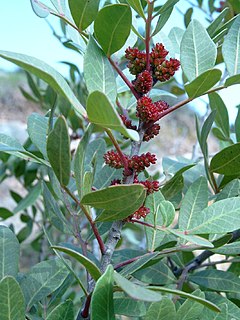
Pistacia lentiscus is a dioecious evergreen shrub or small tree of the genus Pistacia native to the Mediterranean Basin. It grows up to 4 m (13 ft) tall and is cultivated for its aromatic resin, mainly on the Greek island of Chios and around the Turkish town of Çeşme.

Mount Pentelicus or Pentelikon is a mountain in Attica, Greece, situated northeast of Athens and southwest of Marathon. Its highest point is the peak Pyrgari, with an elevation of 1,109 m. The mountain is covered in large part with forest, and can be seen from southern Athens (Attica), the Pedia plain, Parnitha, and the southern part of the northern suburbs of Athens. Houses surround the mountain, especially in Vrilissia, Penteli, Ekali, Dionysos and north of Gerakas. Marble from Mount Pentelicus is of exceptionally high quality and was used to construct much of the Athenian Acropolis. Later, Pentelic marble was exported to Rome, where it was used in construction and in sculptures.
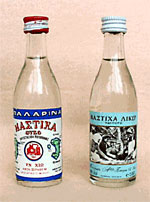
Mastika or mastiha is a liqueur seasoned with mastic, a resin with a slightly pine or cedar-like flavor gathered from the mastic tree, a small evergreen tree native to the Mediterranean region. In Greece, mastiha or mastichato is a sweet liqueur produced with the mastika resin from the Greek island of Chios, which is distilled after hardening to crystals. Sugar is typically added. It is a sweet liqueur that is typically consumed at the end of a meal. It has a distinctive flavor, reminiscent of pine and herbs. It is claimed to have medicinal properties and to aid digestion.

Agriculture in Greece is based on small, family-owned dispersed units, while the extent of cooperative organization stays at low comparative levels, against all efforts that have been taken in the last 30 years, mainly under European Union supervision. Greek agriculture employs 528,000 farmers, 12% of the total labor force. It produces more than 14% of the national GDP

Çeşme is a coastal town and the administrative centre of the district of the same name in Turkey's westernmost end, on a promontory on the tip of the peninsula that also carries the same name and that extends inland to form a whole with the wider Karaburun Peninsula. It is a popular holiday resort and the district center, where two thirds of the district population is concentrated. Çeşme is located 85 km west of İzmir, the largest metropolitan center in Turkey's Aegean Region. There is a six-lane highway connecting the two cities. Çeşme district has two neighboring districts, Karaburun to the north and Urla to the east, both of which are also part of İzmir Province. The name "Çeşme" means "fountain" and possibly draws reference from the many Ottoman fountains that are scattered across the city.

Mastichochoria is a former municipality on the island of Chios (Χίος), North Aegean, Greece. Since the 2011 local government reform it is part of the municipality Chios, of which it is a municipal unit. It is located in the southwestern and extreme southern part of the island. It is the largest municipal unit in land area on Chios at 211.687 km2. Its population was 3,672 at the 2001 census. The seat of the municipality was Pyrgi (Πυργί). The next largest villages are Kalamotí (Καλαμωτń) (569), Armólia (Αρμόλια)(442), Mestá (Μεστά) (337), and Lithío (Λιθί) (397). The small coastal village of Emporeios (Εμποριού)(47) boasts an archaeological site.

The Yellowstone fires of 1988 collectively formed the largest wildfire in the recorded history of Yellowstone National Park in the United States. Starting as many smaller individual fires, the flames quickly spread out of control due to drought conditions and increasing winds, combining into several large conflagrations which burned for several months. The fires almost destroyed two major visitor destinations and, on September 8, 1988, the entire park was closed to all non-emergency personnel for the first time in its history. Only the arrival of cool and moist weather in the late autumn brought the fires to an end. A total of 793,880 acres (3,213 km2), or 36 percent of the park, burned at varying levels of severity.
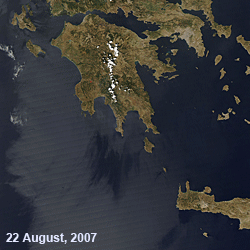
The 2007 Greek forest fires were a series of massive forest fires that broke out in several areas across Greece throughout the summer of 2007. The most destructive and lethal infernos broke out on 23 August, expanded rapidly and raged out of control until 27 August, until they were finally put out in early September. The fires mainly affected western and southern Peloponnese as well as southern Euboea. The death toll in August alone stood at 67 people. In total 84 people lost their lives because of the fires, including several fire fighters.

Mastic is a resin obtained from the mastic tree. It is also known as tears of Chios, being traditionally produced on the island Chios, and, like other natural resins, is produced in "tears" or droplets.
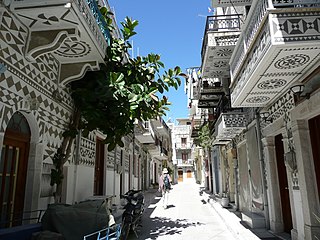
Pyrgi is a village on the Greek island of Chios, known as the "painted village" on account of the decoration of the houses. This mostly consists of black and white decorative motifs in different shapes. Pyrgi is one of the biggest villages in Chios, located in the south part of the island, 25 km south of the island's capital. It is the traditional seat of the Mastic Villages, a group of villages where the residents engage with mastic agriculture. These villages have been added in representative List of the Intangible Cultural Heritage of Humanity of UNESCO. The population of Pyrgi is 755 inhabitants according to the 2011 census.
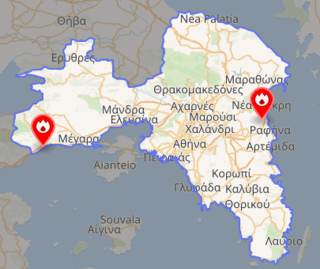
A series of wildfires in Greece, during the 2018 European heat wave, began in the coastal areas of Attica in July 2018. 104 people were confirmed dead from the Mati fires. The fires were the second-deadliest wildfire event in the 21st century, after the 2009 Black Saturday bushfires in Australia that killed 173.

Nasuhzade Ali Pasha, commonly known as Kara Ali Pasha, was an Ottoman admiral during the early stages of the Greek War of Independence. In 1821, as second-in-command of the Ottoman navy, he succeeded in resupplying the isolated Ottoman fortresses in the Peloponnese, while his subordinate Ismael Gibraltar destroyed Galaxeidi. Promoted to Kapudan Pasha, and led the suppression of the revolt in Chios and the ensuing Chios massacre in April 1822. He was killed when a fireship captained by Konstantinos Kanaris blew up his flagship in Chios harbour on the night of 18/19 June 1822.
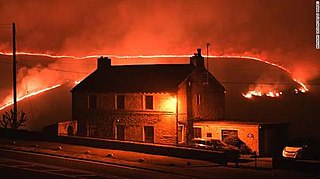
2019 United Kingdom wildfires were a series of wildfires that began on 26 February 2019 and ended on 18 May 2019. The series of wildfires was considered unusual due to the fact that they took place early in the year. Areas affected by the wildfires in 2019 included those that had already been burnt by wildfires during the summer of 2018. The fires have created many air pollution problems for the UK. The causes of most of the fires have been attributed to much higher than average temperatures and drought conditions that have prevailed since the spring of 2018. There were 137 wildfires larger than 25 hectares (250,000 m2) recorded in the United Kingdom in 2019. This beats the previous record of 79 from 2018.

During August 2019, a number of forest fires broke out in the Canary Islands of Gran Canaria, Tenerife and Lanzarote. The fires on the island of Gran Canaria were the most severe, resulting in the loss of large areas of the island's forests and leading to the evacuation of thousands of residents from a number of towns and villages. The intense heat brought by a heat wave and the presence of strong winds, combined with the island's mountainous terrain, made extinguishing activities exceptionally difficult.
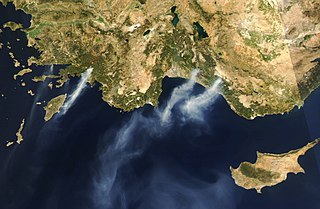
In July and August 2021, a series of more than two hundred wildfires burnt 1,700 square kilometres of forest in Turkey's Mediterranean Region in the worst-ever wildfire season in the country's history. The wildfires started in Manavgat, Antalya Province, on 28 July 2021, with the temperature around 37 °C (99 °F). As of 9 August 2021, two fires were still burning, both in Muğla. The fires are part of a larger series of wildfires, including those in neighbouring Greece, originating from a heatwave made more likely by climate change.

The 2021 Greece wildfires were multiple wildfires in Greece in August 2021, which killed 3 people, injured at least 20 others and burned dozens of homes, after a historic heatwave for the country, with the highest temperatures reaching 47.1 °C (116.8 °F). Authorities evacuated several villages and towns. According to BBC News, Greece experienced the worst heatwave since 1987. These fires were the worst fires in Greece since the 2007 Greek forest fires which burnt more than double the area of the 2021 fires.

In June through August 2022, parts of Europe, the Middle East and North Africa were affected by wildfires. The bulk of the fires affected Mediterranean Countries, with the main areas affected being Algeria, France, Greece, Portugal and Spain.
References
- ↑ http://www.wwf.gr/images/pdfs/Oikologikos_apologismos_pyrkagias_chiou.pdf [ bare URL PDF ]
- 1 2 3 4 "Major fire on eastern Greek island of Chios" at boston.com (20 August 2012)
- 1 2 "Forest / Wild Fire in Greece on Saturday, 18 August, 2012 Archived 2 April 2015 at the Wayback Machine " at RSOE EDIS
- 1 2 3 "Wildfire sweeps across Greek island of Chios" at bbc.co.uk (20 August 2012)